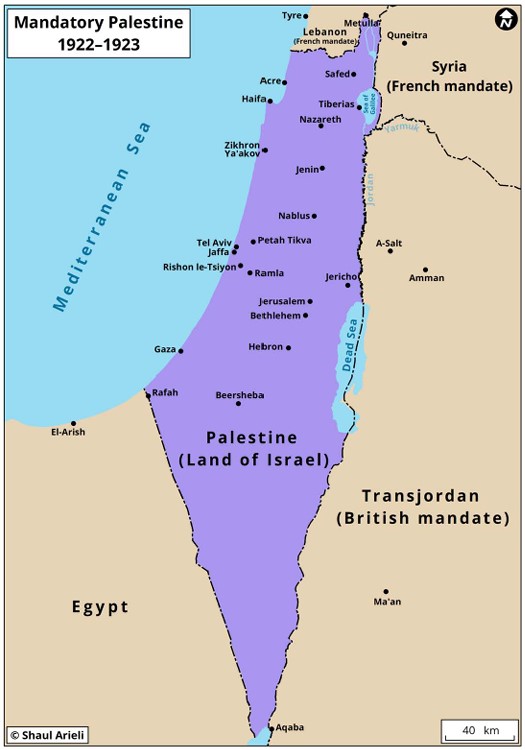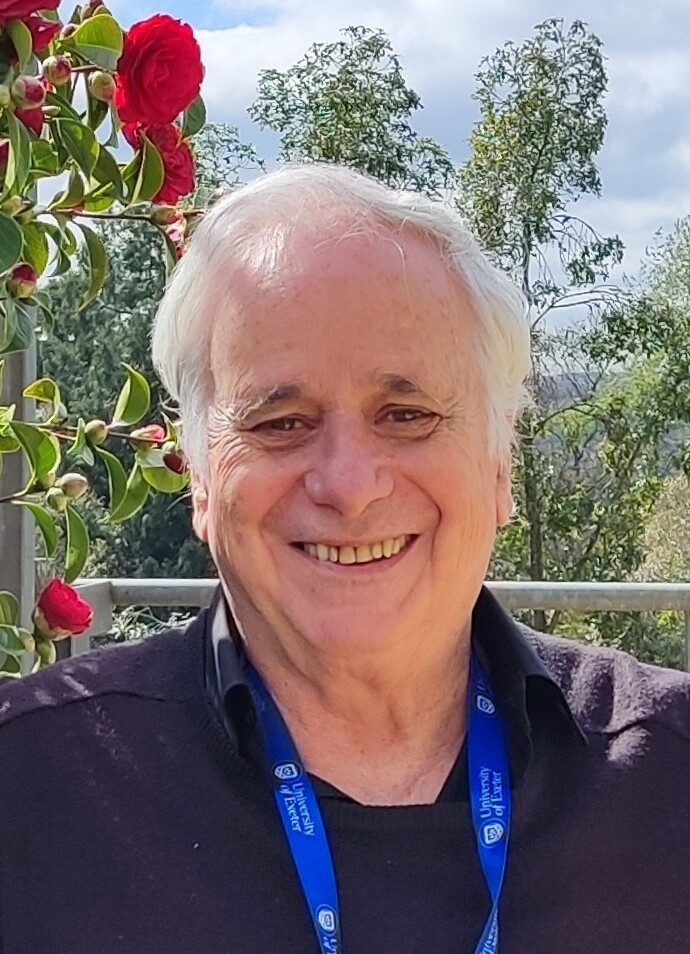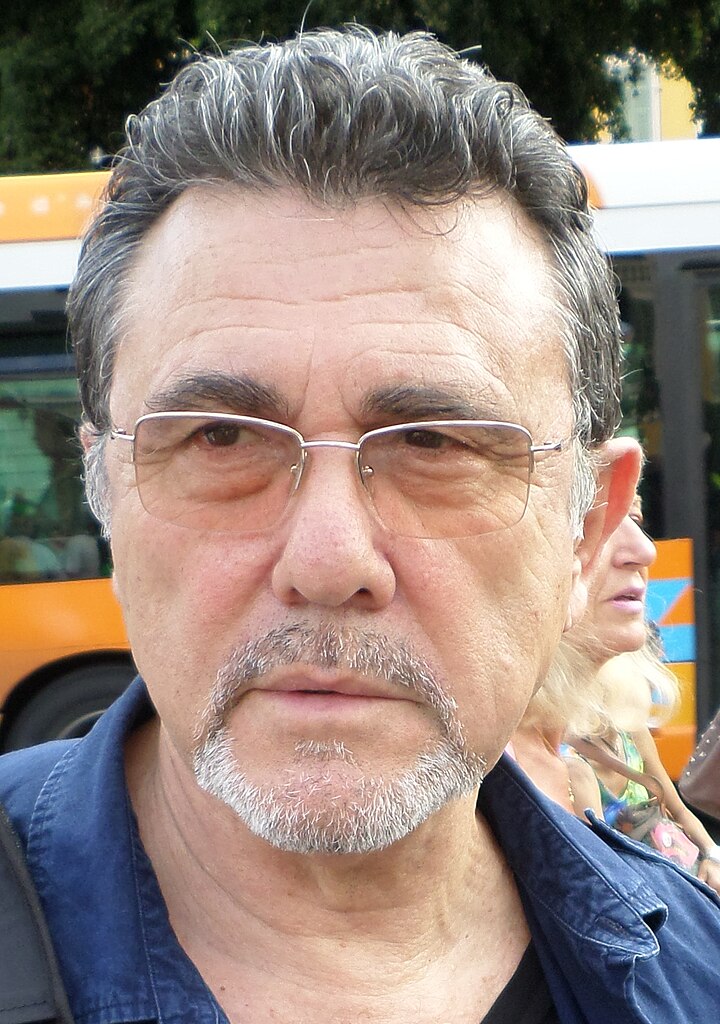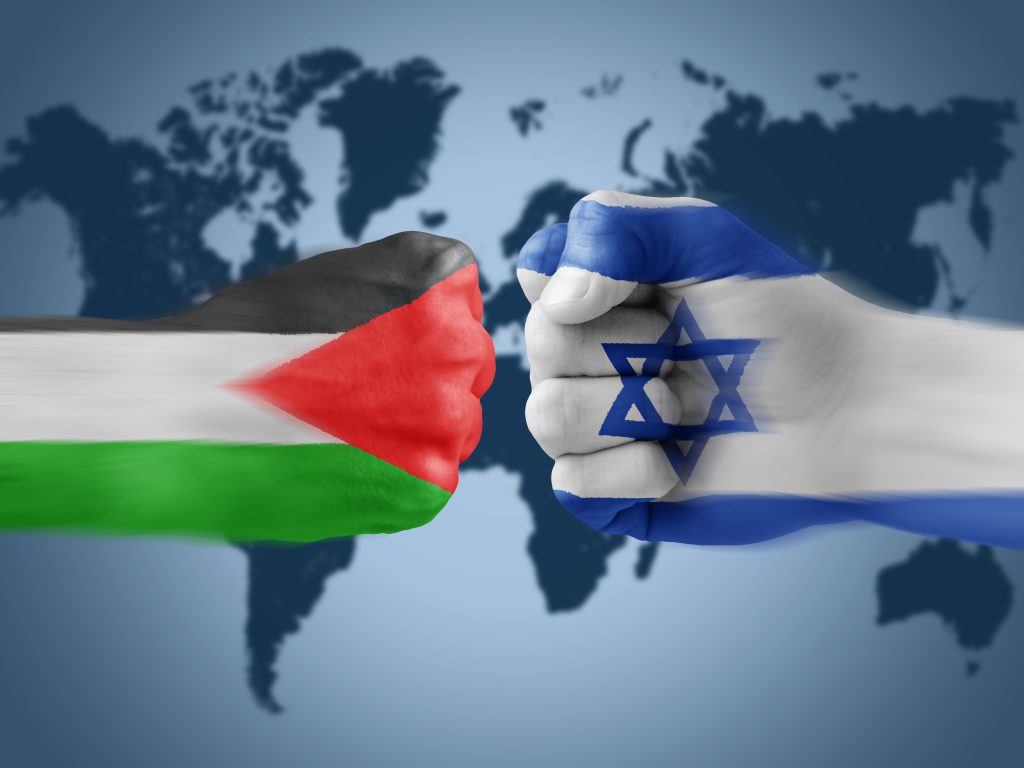The focus of this short episode is my proposed Multi-Layered Model of the Zionist Narrative. It will be used as a framework for the entire Palestine Series. I also cover other key terminology, a short overview of my objectives, sources and approach to provide everything you need as context for this series.
E1.1 Key Terminology
Let’s quickly talk about terminology. I do not provide a long up-front terminology section, but will rather define important terms as I introduce them. However, there are a few key terms I use throughout, which I have to define broadly at the outset:
- I use the term Palestine (or historical Palestine) to indicate the area that was under British rule as “Mandatory Palestine”, before the UN Partition Plan in UN Resolution 181 of 1947. It does not refer just to the current Palestinian Territories. The reasons for this term are:
-
- To find a single and accurate term to use for this entire area
- To avoid political connotations, by selecting a historical term preceding the current political dispensation by many centuries
- The name “Palestine” goes back 4,000 years at least, it started to replace the name “Canaan” from about the 5th century BCE and it became the most common name for this region since Roman rule started in 63 BCE. The Romans officially renamed it “Provincia Syria Palaestina” in 135 CE after the Bar Kokhba Revolt, and it became “Provincia Palaestina” under the Bizantyne Empire.

- Zionism is defined in a general sense to mean an ideology advocating (or supporting) a Jewish State in historical Palestine. It is simply a factual definition and the term is by no means a slur (even though it is taken and used as such by some people). The core of Zionism is contained in Layer 3 of my multi-layered model of the Zionist Narrative in E1.3 below.
- And what is all this talk about narratives? For the purpose of this series I define “Narrative” as follows:
- A story, or system of related stories, which articulates some form of belief system
- These narratives can be religious or ideological in nature, or a combination of the two. Ideological narratives can be political or economic ideologies (like nationalism or freemarket fundamentalism). Any form of bigotry (like racism, chauvenism, homophobia, and xenophobia) typically involves a narrative too, which is often part of a wider ideological or religious narrative
- Complex narratives can be inherently incoherent, and often are
- Bigger and more ambitious narratives tend to make transcendent claims to universal and lasting validity
- They often place themselves above rational scrutiny
- The success of political and religious narratives are quite dependent on the extent to which they resonate with people. A superior, socially beneficial or historically more accurate narrative does not necessarily resonate better than an inaccurate or toxic one; quite the contrary
- The narratives which are especially resistant to rational scrutiny are
- Narratives people are raised with and which form part of their identity
- Narratives which resonate strongly with them, and some of the best examples of this are narratives which appeal to core human biases and prejudices
- Narratives involving divine beings
- I use BCE for Before the Common Era (instead of the Christian-centric BC “Before Christ”), and CE for Common Era (instead of the Christian-centric AD “Anno Domini” or “The year of our lord”)
- The term “Jew” or “Jewish people” will deliberately not be defined yet. It is by no means as clear-cut as popularly believed, but a rather complex issue which will only be explored in view of relevant historical facts. Chapters 4, 6 and 7 will shed more light on this.
E1.2 Objectives



The 6 rather ambitious objectives of this series
- Objective 1: To provide a comprehensive and accurate historical overview of the entrenched conflict in historical Palestine and what the driving forces are. I hope this will also serve as a useful general historical perspective and a reference work for future use
- This is essential to understand the situation and evaluate the narratives
- It was quite a challenge not to lose the view of the forest for the trees. Several deep dives were required as critical insights are often buried quite deep within the historical details. Relevance to the series theme was always the guiding principle in excluding a mountain of related historical facts
- Since many Western sources simply repeat the Zionist narrative when providing historical overviews, a much closer look was required. It is obviously impossible to get an objective historical overview from within an existing narrative, so this was not done from within any of the competing narratives. I think this should be valuable and refreshing
- Objective 2: To bring rational scrutiny to the Zionist Narrative (as per the model in E1.3 below)
- In an attempt to be objective and escape Western myopia I address a variety of narratives playing a role on all sides (Christian Zionism, anti-Semitism, Islamophobia, colonialism, nationalism, Pan-Arabism, Islamism, Jihadism, the narrative of the “Judeo-Christian” tradition, more mainstream Judaist, Christian and Islamic narratives, among others)
- However, my focus remains the Zionist narrative
- Objective 3: To promote critical thinking
- By raising awareness about narratives and their crucial role in the way humans view the world (and there is hardly a topic today which better demonstrates the power of narratives than Palestine)
- By bringing rational scrutiny to some of these well-established narratives as examples (the stories “we think we know best”)
- In this regard, I don’t think/pretend that I’m completely objective and free of the influence of narratives. However, I realize that the narratives I value are just narratives. I don’t regard my narratives as “true” or “eternal”, I changed my core narratives. I accepted the new ones after rational scrutiny, for the balance of social benefit they can bring and I still keep an open mind about them
- Objective 4: To make a modest contribution to help our species overcome our deep-seated tribalism
-
- This is related to Objective 3, but it deserves special attention
- I will investigate how specific narratives resonate with our tribalism and how tribalism is an evolutionary outcome
-
- Objective 5: To specifically investigate the role of religion in these narratives and the ongoing conflict in Palestine
- Objective 6: To conclude with a critical secular perspective, which follows on from Objective 5 and is desperately needed in my view.
E1.3 A Multi-Layered Model of the Zionist Narrative
- In order to bring rational scrutiny to the Zionist narrative I constructed a multi-layered model to analyze it, as it seems to operate on different levels
- To the best of my knowledge this model is an innovative one
- I believe it can be valuable for analysis and conceptual clarity
- Reflecting the Zionist Narrative in this model is not presenting it as factual or condoning it in any way. It is an effort to accurately describe it in order to critically assess it
- My Multi-Layered Model of the Zionist Narrative:
-
- It is hierarchical, with this hierarchy in historical sequence: Layer 1 is the oldest and the foundation layer, all the way to Layer 5 on top, as the Contemporary Layer which is used by Zionists to frame current events
- One layer build upon the previous layer(s) as the Zionist narrative continued to develop historically
- The bottom 2 layers (L1 & 2) are part of the narrative of Judaism and strictly speaking not Zionism as such (the reason for the dotted line running through the diagram)
- Zionism added Layers 3 – 5 to some of these core narratives of Judaism
- It nevertheless built upon L1 & 2, and turned these into foundational narratives for Zionism too
- But the new development was the Layer 3 Narrative which was added in the 19th century and created Zionism (and which we’ll cover in Episode 7)
- Diagrammatically I use an inverted pyramid, as the subsequent layers seem to grow bigger than their foundations. Please read it bottom up. It is possibly also a little symbolic as this narrative seems to be increasingly overloaded and unstable
- The content on the diagram is rather cryptic due to space limitations. This will be elaborated on as each layer is assessed
- Like any model it has its limitations
- For example, it is by definition simplified (like any model)
- Any complex narrative contains variences and internal differences. My focus was to capture the core of the Zionist narrative by working with the prevailing views of the main Zionist leaders. I look at some differences along the way, although these are not reflected in the model itself, for practical reasons
- Understanding and assessing the Zionist narrative and the history of Israel cannot be done properly without addressing all 5 layers. This in turn requires a start during the Bronze and Iron Ages with Layer 1. And the Bronze Age is by no means boring, it’s a fascinating and consequential period in history!
E1.4 Sources
- I made an effort to use a wide variety of sources: reputable and objective sources, academic sources, encyclopedias, news articles, official Israeli and Palestinian sources
- This includes several sources from both sides with a clear bias: official websites of Hamas, the PLO, the Israeli government, as well as Zionist historians and websites. A typical example of such a Zionist Historian is Ben-Zion Dinur (1884 – 1973) and Israel’s Minister of Education 1951 – 1955. One of his most notable publications was “Israel in Exile” (1958, 2nd Edition)
- For the historical deep dives into the most contentious parts of history, I extensively used the offical IDF archives, which were declassified in the 1980s
- I especially found the “new” Jewish historians useful. As both Jews and professional historians, they more than anybody, were meticulous and critical in grappling with the historical evidence and its deviation from the traditional biblical and Zionist narratives. These include academics like Profs. Ilan Pappe, Avi Shlaim, Shlomo Sand and to some extent Benny Morris
- I also include several more popular (rather than just academic) sources. I mostly include them as additional reading for those so inclined. Please keep in mind that many of these popular sources do not offer critical analyses and often simply follow the dominant narratives in the West. It remains important to consult critical historical/academic sources for an accurate picture
- A topic like this is much easier digested with the use of clear maps. A good source for maps is the book “The Truman Institute Atlas of the Jewish-Arab Conflict” by Shaul Arieli. I cross-checked his maps against several other sources and they seem quite accurate, but more colourful and clear. Arieli served in the IDF and regards himself as a Secular Zionist. Wikimedia Commons and the World History Encyclopedia are also two good public domain sources
- There will be a section showing the sources used for each historical episode (S1E02 – S1E17), at the end of the episode. This can be collapsed or expanded as required.
The “New Historians”



E1.5 Approach
E1.5.1 Historiographical Challenges and Developments
- When dealing with history it is important to be aware of historiographical challenges and developments, including the 11 quotes mentioned above
- Three specific historiographic pitfalls to be cautious about
- Viewing the world (and the past) through the lens of specific narratives and naively regarding these narratives as historical fact
- Presentism: viewing the past through the lens of present-day facts and perspectives, and in this process erroneously projecting the present into the past (including current ideologies and issues). A good and important example is viewing ancient history with the mindset of modern nation states, which is a very recent phenomenon
- Viewing the Palestinian history completely through a Western lens, which is what Biblical Archeology and many Western historians did until recently (western myopia as some scholars call it today). This includes viewing it through the lens of the predominant Western religion, the Christian narrative
- There were specifically a number of key developments over the last 50-60 years which vastly improved our understanding of the history of Palestine (the first two developments regarding ancient history and the last two regarding contemporary history):
- Due to the influence of the Bible and Christianity there was a long-standing fascination with Palestine and its archeology since the second half of the 19th century. However, since the late 1960s there was a substantial increase of excavations and archeological investigation in the area, also outside of the green line. This brought many important new facts to light
- Archeological methodology became more scientific and adopted a more comprehensive anthropological approach. This gained additional momentum due to new technology (like carbon dating and especially carbon-14 dating), as well as a new generation of archeologists willing to investigate the evidence more critically, as the mountain of discrepancies between the Biblical stories and the archeological evidence became too much to paper over
- From the 1980s the Israeli government declassified a large part of their archives and gave historical researchers access to it
- A new generation of Jewish historians came to the fore who critically and throughly researched these archives. They became known as the so-called “new historians” and they brought significant new facts and insights.
E1.5.2 My Approach
‘…one does not have to accept either of the opposing narratives. One can, and should, critically assess both/all of them’
- I write primarily for a Western audience, as my readership is largely Western
- This audience is much more likely likely to have had more exposure to Israeli and US propaganda than to Hamas propaganda
- They’re also more likely to be influenced by the narratives of Christianity and Judaism, than by Ismaic narratives
- If this series was primarily targeted at a Middle Eastern audience I would have used a different approach and focus
- I largely follow a chronological approach, but divide them into specific historical themes in order not to just present a series of disjointed but strictly chronological facts
- There will inevitably be some chronological overlap between these bigger themes
- These themes are structured into episodes, with the added objective to divide the series into more manageable chunks
- In order to provide an objective overview
- I mostly present factual information during the main content of each episode, and make every effort to present that in an accurate and balanced way
- I added a “Critical Insights” section at the end of each episode in which I make comments, ask critical question and draw provisional conclusions. I endeavour to bring these insights together in the Critical Secular Perspective in Episode 18
- This series is also an invitation
- To try and keep an open mind about the fact and reflect on new information and perspectives
- To keep in mind that the general US perspective on this (which you no doubt had lots of exposure to), is far from objective. I will provide good examples along the way
- To contemplate that it is possible for both sides to have legitimate aspirations and grievances (and to commit atrocities). I’m by no means driving towards moral equivalence here, I’m simply suggesting a more objective investigation of the historical facts and following that wherever it leads
- To not apply a simple dichotomy to the analysis of this complex issue. Do not try to frame the parties from the outset as “the good guys” and “the bad guys”
- Most of all, to realize that
- Criticizing Israel or Zionism does not make one an “antisemite” or a Hamas supporter
- Just like criticizing Hamas does not make one an “Islamophobe” or a “Zionist”
- This topic does not have to be viewed as an “either or” proposition (and even less as a black and white situation), one does not have to accept either of the opposing narratives. One can, and should, critically assess both/all of them.
Episode 2 will start the historic overview with the fascinating and consequential Bronze Age! Please proceed with our pilot episode and enjoy the series!






